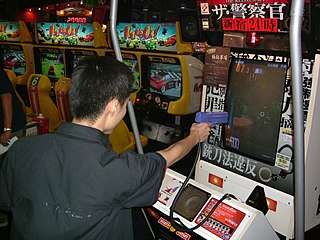
An arcade video game takes player input from its controls, processes it through electrical or computerized components, and displays output to an electronic monitor or similar display. All arcade video games are coin-operated or accept other means of payment, housed in an arcade cabinet, and located in amusement arcades alongside other kinds of arcade games. Until the early 2000s, arcade video games were the largest and most technologically advanced segment of the video game industry.
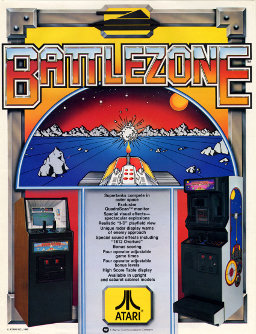
Battlezone is a first-person shooter tank combat game released for arcades in November 1980 by Atari, Inc. The player controls a tank which is attacked by other tanks and missiles. Using a small radar scanner along with the terrain window, the player can locate enemies and obstacles around them in the barren landscape. Its innovative use of 3D graphics made it a huge hit, with approximately 15,000 cabinets sold.
Full-motion video (FMV) is a video game narration technique that relies upon pre-recorded video files to display action in the game. While many games feature FMVs as a way to present information during cutscenes, games that are primarily presented through FMVs are referred to as full-motion video games or interactive movies.
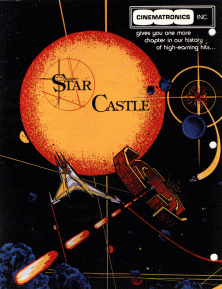
Star Castle is a vector graphics multidirectional shooter released in arcades by Cinematronics in 1980. The game involves obliterating a series of defenses orbiting a stationary turret in the center of the screen. The display is black and white with the colors of the rings and screen provided by a transparent plastic screen overlay.
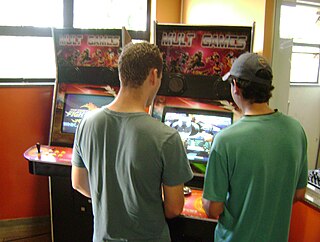
An arcade cabinet, also known as an arcade machine or a coin-op cabinet or coin-op machine, is the housing within which an arcade game's electronic hardware resides. Most cabinets designed since the mid-1980s conform to the Japanese Amusement Machine Manufacturers Association (JAMMA) wiring standard. Some include additional connectors for features not included in the standard.
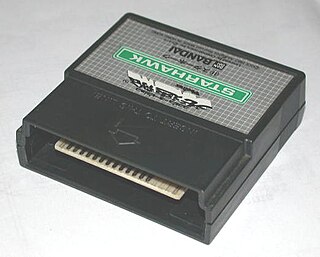
Starhawk is a 1979 vector arcade game designed and programmed by Tim Skelly and manufactured by Cinematronics. Starhawk is a shoot 'em up unofficially based on the Star Wars: Episode IV trench run, one of the first arcade games to blatantly use concepts from Star Wars. The game was unique at the time for its pseudo-3D graphics. It was distributed in Japan by Sega, and was later ported for the Vectrex home system in 1982.

Cinematronics Incorporated was an arcade game developer that primarily released vector graphics games in the late 1970s and early 1980s. While other companies released games based on raster displays, early in their history, Cinematronics and Atari, Inc. released vector-display games, which offered a distinctive look and a greater graphic capability, at the cost of being only black and white (initially). Cinematronics also published Dragon's Lair in 1983, the first major LaserDisc video game.
The following article is a broad timeline of arcade video games.
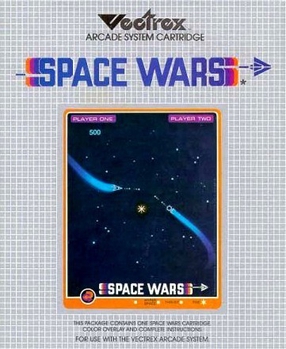
Space Wars is a shooter video game released in arcades by Cinematronics in 1977. It is based on the PDP-1 game Spacewar! (1962) but instead uses vector graphics for the visuals. The hardware developed for Space Wars became the platform for most of the vector-based arcade games from Cinematronics. It was distributed in Japan by Taito in 1978, and a Vectrex port was published in 1982.

The R360 is a motion simulator arcade cabinet produced by Sega. It was first released in Japan in 1990, and internationally a year later. Being short for "Rotate 360", the R360 is noteworthy for its ability to spin 360 degrees in any direction on two metal axis, allowing the player to freely move as the cabinet mimics the in-game action, including the ability to turn completely upside down. A safety bar and four-point safety harness are utilized to keep players in the seat as the machine moves. An emergency stop button is also present both inside the machine and on the attendant tower. Gyroscope technology is used for the motion.
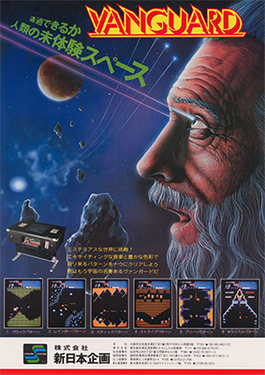
Vanguard is a scrolling shooter arcade video game developed by TOSE. It was released by SNK in Japan and Europe 1981, and licensed to Centuri for manufacture in North America in October and to Zaccaria in Italy the same year. Cinematronics converted the game to cocktail arcade cabinets in North America.
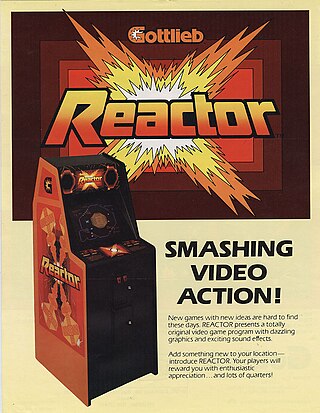
Reactor is an arcade video game released in 1982 by Gottlieb. The object of the game is to cool down the core of a nuclear reactor without being pushed into its walls by swarms of subatomic particles. Reactor was developed by Tim Skelly, who previously designed and programmed a series of vector graphics arcade games for Cinematronics, including Rip Off. It was the first arcade game to credit the developer on the title screen. Reactor was ported to the Atari 2600 by Charlie Heath and published by Parker Brothers the same year as the original.

Rad Mobile is a racing arcade game developed by Sega AM3 and published by Sega. It was first published in Japan in October 1990, followed by an international release for arcades in February 1991. Rad Mobile was Sega's first 32-bit game, using Sega's System 32 arcade system board. It was also the first appearance of Sonic the Hedgehog, who appears as an ornament hanging from the driver's rearview mirror.

Space Fury is a 1981 multidirectional shooter arcade game developed by Gremlin. Sega/Gremlin released the game in North America in June 1981, and then Sega released it in Japan in July 1981. It is the first game with color vector graphics, and it was Sega's second game to use speech synthesis. Coleco published a ColecoVision version with raster graphics in 1983.

Armor Attack is a multidirectional shooter designed by Tim Skelly and released as an arcade video game by Cinematronics in 1980. It was licensed to Sega for release in Japan and also to Rock-Ola. The vector graphics of Armor Attack present combat between the player's jeep and enemy vehicles in an overhead, maze-like view of a town. The buildings are not drawn in the game, but are an overlay that sits on top of the monitor. The overlay also tints the vectors green.
Tim Skelly was a video game designer and game programmer who developed arcade games for Cinematronics from 1978 until 1981. He designed a series of pure action games using black and white vector graphics. One of his early games, Rip Off, was the first arcade game with two-player cooperative play. Star Hawk, Rip Off, Armor Attack, and Star Castle were all later ported to the Vectrex home system.
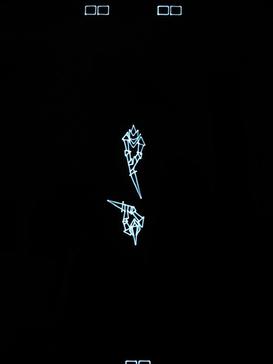
Warrior is a 1979 arcade fighting game. It is considered one of the first fighting games, excepting several boxing games such as Heavyweight Champ, released in 1976, and Atari's unreleased Boxer.
Vectorbeam was an arcade game manufacturer active in the late 1970s who specialized in vector graphics-based arcade games. It was formed after splitting off from its primary competitor, Cinematronics, and disappeared after re-merging with them soon after.
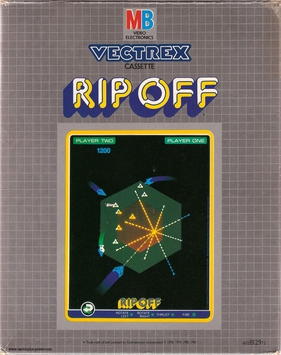
Rip Off is a multidirectional shooter with black and white vector graphics written by Tim Skelly and released as an arcade video game by Cinematronics in 1980. It was the first shooter with cooperative gameplay and an early game to exhibit flocking behavior. A port for the Vectrex was published in 1982.
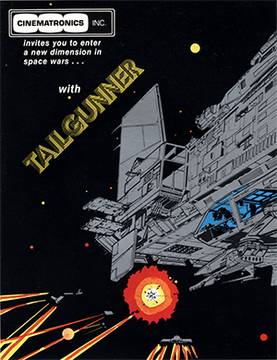
Tail Gunner is a monochrome vector arcade game created by Vectorbeam in 1979. The premise of the game is that the player is the tailgunner of a large space ship. Enemy spacecraft attack the vessel in groups of three, and the player must aim a set of crosshairs and shoot the enemies before they slip past the player's cannons. Because of the game's viewpoint, instead of appearing to fly into the starfield, the stars move toward the left and center of the screen.
















